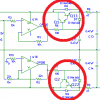- Joined
- Jan 21, 2010
- Messages
- 25,510
kinda stabilized on number 6
A reading of 6 from your calibrated finger is close to the maximum temperature you'd expect a transistor to get to and survive. Clearly, cooler would be better. I'd recommend you replace these transistors with something capable of higher current, possibly even a darlington pair.
I would also recommend that you permanently solder those 2k resistors across the power supply output to prevent the voltage rising if there is no load.
Where do you purchase components from? Are they on-line? I'll see if I can pick something out for you.
Alternatively, you could go for the 7805/7905 that I was recommending previously. I can redraw the power supply to show you how to use them.
now the measurments-
R channel
R1 - 0.926v - 12.3mA
R3 - 0.933v - 12.44mA
R8 - 0.366 - 4.88mA
R9 - 1.232v - 16.42mA
L channel
R1 - 0.857v - 11.4mA
R3 - 0.876v - 11.68mA
R8 - 0.371v - 4.94mA
R9 - 1.237v - 16.49mA
as you can see there is a difference between the channels and R8 and R9 are not similar at all. I will check everything for miswiring until your reply
EDIT: seems like I found the miswire. Apparently I didn't understand the schematic correctly. I thought there was a connection between R9 R7 and R6. Resoldering right now.
EDIT: I fixed the mistake. the voltage of R8 and R9 changed to 0.409 and 0.410 respectively (0.404 and 0.405 on the left channel). Plugged it in and... it works! I almost gave up hope!
I am not much of an audiophile but sound is clear enough, there don't seem to be any noises or distortions. the transistors keep getting hot however, I wonder if that could damage them or if that's a normal temperature for transistors to work on.
Clearly I'm not needed here
I still think the power supply needs improvement, if only to keep the transistors from getting so hot.
As an interim measure, you can get some thin aluminium or similar and make a little flag heatsink for these hot transistors. Bend one end into a cylinder that fits snugly over the transistor and use a dot of epoxy glue to make sure it stays put. Obviously make sure the heatsink doesn't touch the leads. No need to make it huge, 1cm tall and with a flag between 1 and 2 cm will be fine. You know it works if the heatsink gets warm in operation. If that seems good enough, you might decide to leave it that way.
The risk is that failure of these transistors could expose your preamp to the full unregulated voltage. Whilst a heatsink for these transistors might be good enough (and they might survive for a long time even without one), I'd hate for want of such a simple modification that a fault took out your entire preamp.

